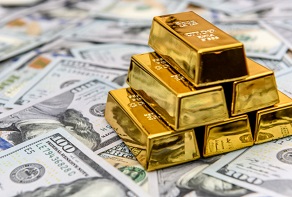Market Watch: Why the U.S. Dollar's Sharp Decline is Driving This Investment Manager - Reluctantly - into Gold

Article by Vitaliy Katsenelson in The Wall Street Journal Market Watch
The U.S. has competitive advantages globally that are rooted in its geography, but the reason the U.S. dollar became the world’s reserve currency is that America has had the largest, strongest (steadily growing and conservatively financed) economy and a stable political system (anchored in the U.S. Constitution).
Yet for the dollar to continue to be valued, the world has to believe in it. Since the end of World War II that’s been the case. People basically looked at the U.S. and many of them concluded that it was the safest place to keep their savings. They didn’t have to worry that if they put their money in the U.S. dollar it would lose its value. The dollar was not going to be diluted by hyperinflation or burned up by a foreign- or civil war. The U.S. political system was stable and strong, and people didn’t have to worry that at some point they wouldn’t be able to take their money out of U.S. banks.
The problem with being the envy of the world is that it changes your behavior. You start believing that you are very special for reasons that are not grounded in reality. You start believing that bad things happen only to other people and nations because they are not as special as you. You can do anything you want — borrow and spend as much as you like — and nothing bad will happen to you. This behavior in turn starts to undermine the core reasons why people trusted your country and currency to begin with.
This is what is now happening to the U.S. In 2020 the ratio of U.S. debt to the output of the economy (debt to GDP) is likely going to exceed 120% (and might be as high as 130%). You can blame the coronavirus pandemic for some of that, but the national debt has been going up steadily. The U.S. has run huge budget deficits in bad times and in good, long before the virus.
In 2000, U.S. debt was $6 trillion — a 30% debt to GDP ratio. It was $14 trillion in 2010 and $23 trillion in 2019, increasing $1 trillion a year while the U.S. economy was booming. Or maybe this is why the economy was booming. The U.S. was charging $1 trillion a year, year after year, on its national credit card to buy things and to engineer this growth.
By 2019, 10 years after the Great Financial Crisis, the Fed was still running its policy of quantitative easing. Debt to GDP at that time topped 100% — eclipsing the EU’s ratio of 86%. (Yes, the capitalist U.S. is more indebted than the “socialist” EU). We have not acutely felt that debt burden, because interest rates declined over the last two decades.
Then COVID-19 arrived. The U.S. has spent 12% of GDP (so far) to keep its economy afloat during the shutdown — twice as much in terms of GDP as the rest of the world, four times as much as the largest European countries, three times as much as Japan.
Our debt has skyrocketed by perhaps another $6 trillion — it’s too soon to tell. The Fed already owned $2.5 trillion of U.S. government bonds in 2019, and now it owns $3.7 trillion worth and is a buyer of U.S. corporate bonds and ETFs. Stocks are likely to be next.
Consequently, credit rating agencies have put AAA-rated U.S. government debt on “negative watch,” signaling a possible downgrade.
The dollar’s decline may bring higher prices, higher inflation, and higher interest rates (the Fed will try to squash interest rates, until it cannot). In my firm’s portfolios we are already partially positioned for this shift by owning foreign stocks — a weaker dollar means foreign company earnings will go up in the U.S. dollar terms.
But there is another asset we’re buying — gold.
This is something we have resisted doing for a long time. There are so many reasons why I don’t want to like gold, but gold hedges our clients against two scenarios: a weaker U.S. dollar and the debasement of all currencies (the dollar declines and so do other currencies). Dollar outflows will be looking for homes. Some money will flow into euros, British pounds, and Swiss francs, and some into gold — an incorruptible asset class (central banks and politicians cannot create more gold).
In the past our justification for not owning gold was ...
To read this fascenating article in Market Watch in its entirety, click here.